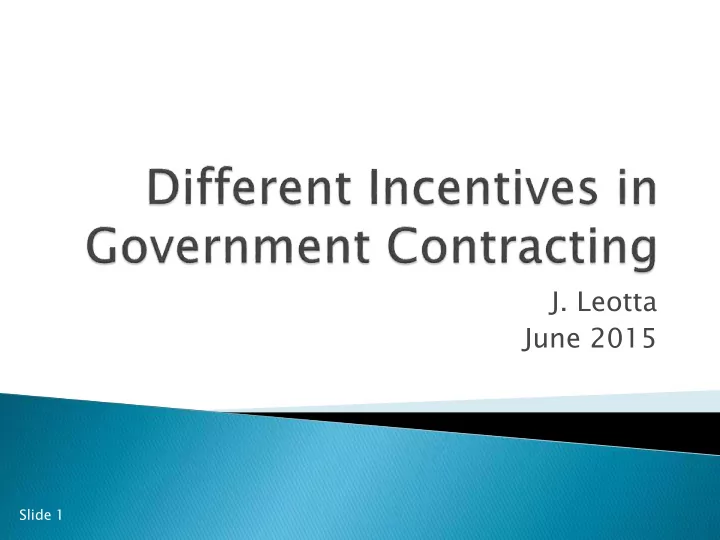

J. Leotta June 2015 Slide 1
Introduction Incentive Fee Contracts Principal-Agent Problem Stock Pricing Theory Case Study 1: Public Sector Case Study 2: Private Sector Alternate Contract Incentives Conclusions Slide 2
Government Spending ◦ Discretionary spending is decreasing to its lowest level since just after World War II ◦ Non-Discretionary spending is on a projected path to increase from 10% to 16% of GDP by 2031 Cost overruns negatively impact discretionary funding Slide 3
Initially seen as a way to ensure that the government did not waste money on cost overruns so funds could be available to pursue as many projects as possible Key Principle: ◦ Share the risk between the Government and Contractor through the contract’s fee structure Types of Contracts Cost Reimbu bursab able le Fixed Cost Cost Plus Fixed Fee Firm Fixed Price (FFP) (CPFF) Cost Plus Incentive Fee Firm Price Incentive Fee (CPIF) (FPIF) Slide 4
Cost Overruns are still prevalent in government contracting Actu ctual Depart rtme ment nt/ Esti timat mate Year r of (or r Year r of Perc rcent ent Progra ogram Agenc ency d Cost Esti timat mate rece cent nt Actu ctual Overr errun un esti timat mate) F/A-22 22 Rapt ptor or Defense $117M 1992 $254M 2002 117% V-22 2 Osprey rey Defense $36M 1987 $93M 2001 158% Patr triot ot Advanc nced Defense $5M 1995 $10M 2002 100% Missi ssile les Denve nver r Intern ternati tion onal Transportation $1.7B 1989 $4.8B 1995 182% Airp irport ort FBI BI Tril ilogy ogy Justice $477M 2000 $600M 2004 26% Comput uter er Syst stem em Inter terna nati tion onal l Space ce NASA $17B 1995 $30B 2002 76% Stati tion on Slide 5
Misalignment of goals between the principal (firm) and the agent (executives) Wage contracts used to align the incentives of the agent to match the firm’s incentives ◦ Present Solution: Stock compensation Can the “stock solution” be applied by the government (customer) to motivate their contractors? Slide 6
In general, stocks fluctuate due to market forces ◦ Analysts base the expected future value of a company on their earnings projects Dividend Discount Model ◦ The stock price is equal to the present value of its future stream of dividends Stock k Price = D/ D/(I-G) G) Slide 7
Program: Joint Strike Fighter (JSF) Contractor: Lockheed Martin Customer Signal September 2014: GAO Report questioning JSF sustainability ◦ Slide 8
Program: JSF Contractor: Lockheed Martin Stronger Customer Signal? March 2010: Nunn-McCurdy Breach ◦ Slide 9
Lockheed’s dividend payouts are constantly increasing over time (2004-2014) Actual exceed predicted dividends Slide 10
Program: Dreamliner 787 Contractor: Boeing Customer Signal ◦ January 2013: 787 Dreamliner grounded due to a series of technical failures Slide 11
Boeing’s dividends saw a larger than expected increase in 2014 787 problems reported Slide 12
Stock prices do not adequately capture customer signals and are ineffective to incentivize the agent (executives) or the principal (firm) Future revenue streams seem to be the primary focus of stock price ◦ How can the customer use future revenues to influence the principal and/or agent? Example: FADS Contract Remaining challenges: alternate streams of revenue Slide 13
Many competing incentives in contracts Stock compensation is an ineffective method for customer signals to influence stock price and thus motivate executives Other methods to align incentives ◦ Credible threat to cancellation ◦ Align executive pay with customer feedback ◦ Use innovative short term contracts to create competition Future Research ◦ Ratio of public vs. private sector revenue streams for companies ◦ Real impact of program cancellation as a credible threat Slide 14
Slide 15
Slide 16
Slide 17
Slide 18
Share re Ratio ios $15M $20M $30M $40M $48M Ratio 90:10 Ratio 80:20 Ratio 70:30 Ratio 60:40 Ratio 50:50 Slide 19
Payout for Incentive Fee Contracts: AP = K + (1-s) X Where: ◦ AP= Adjusted Profit ◦ K= Base Profit ◦ s = Contractor’s share ratio ◦ X = Final Project Cost When s = 0; Cost Plus When s = 1; Fixed d Price Slide 20
The chart shows that CEO pay and compensation have changed dramatically over time Prior to the 1970s ◦ Lower levels of pay and moderate levels of stock and stock option compensation Mid-1970s through the end of the 1990s ◦ Large increases in compensation and dramatic increase in stock compensation After 1990s ◦ Stock compensation is the largest part of executive pay Slide 21
Slide 22
Slide 23
Slide 24
Recommend
More recommend